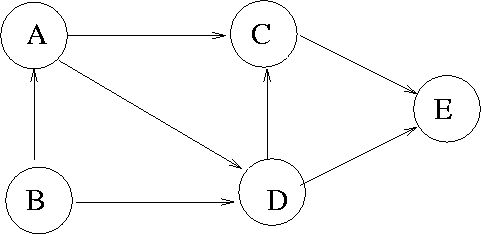


Next:7.5.3
Strong ComponentsUp:7.5
Directed Acyclic GraphsPrevious:7.5.1
Test for Acyclicity
7.5.2 Topological Sort
Topological sort is a process of assigning a linear ordering to the vertices
of a DAG so that if there is an arc from vertex i to vertex
j, then i appears before j
in the linear ordering
-
Useful in scheduling applications
-
Example: Consider the DAG in Figure 7.14.
Figure 7.14: A digraph example for topological sort
 |
A topological sort is given by: B, A, D, C, E. There could be several
topological sorts for a given DAG
-
Topological sort can be easily accomplished by simply including an additional
statement in the depth first search procedure of the given graph.
-
Let number [vertex] be the number that we assign in topological sort. We
use a global integer variable n, whose initial value is zero.
int n = 0;
void topsort (vertex
v);
/* assigns numbers to vertices
accessible from v in
reverse
topological order */
vertex w;
{
mark[v] = visited;
for (w  L[v])
L[v])
if (mark[w] == unvisited)
topsort (w);
number[v] = n+1
}
-
This technique works because a DAG has no back arcs.
Consider what happens when the DFS leaves a vertex x for the last time.
The only arcs emanating from v are tree, forward, and cross arcs. But all
these arcs are directed towards vertices that have been completely visited
by the search and therefore precede x in the order being constructed.



Next:7.5.3
Strong ComponentsUp:7.5
Directed Acyclic GraphsPrevious:7.5.1
Test for Acyclicity
eEL,CSA_Dept,IISc,Bangalore


![]() L[v])
L[v])